Value Capture Case Studies is an ongoing series highlighting ways in which cities and regions across the country are using value capture mechanisms to fund transportation plans. These case studies present novel learnings for the Chicago region as it grapples with how to pay for necessary transportation improvements. Each post will focus on real-life examples of value capture mechanisms at work.
To learn more about the basics of value capture read “Value capture case studies: What is value capture?”
Value capture mechanisms referenced in this post:
The word “no” was not an option when Denver officials began planning to restore the city’s Historic Union Station, built in 1914. According to Frank Cannon, It took that kind of “can do” thinking to piece together the nearly $500 million in funding needed to redevelop the transit hub as the center point of a new transit system and vibrant neighborhood in downtown Denver. Ultimately, the project tapped nine different sources, including an inventive use of two federal loan programs repaid with Tax Increment Financing (TIF) revenues, and a public-private partnership.
Denver Union Station will serve as the hub of the region’s new FasTraks transit system, a $7 billion, 12-year program to build 122 miles of new commuter and light rail, 18 miles of bus rapid transit service, 21,000 new parking spaces at rail and bus stations, and enhanced bus service across the eight-county Regional Transportation District (RTD). FasTraks transit lines will be fully built in 2020.
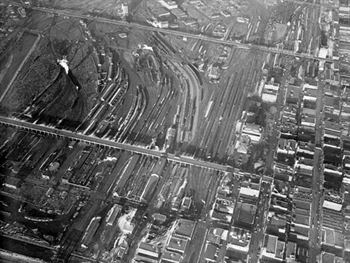
The revitalized Denver Union Station and adjacent community sits on a former rail yard.
After extensive renovation and expansion, Denver Union Station will connect the FasTraks light rail, commuter rail, and intercity rail, as well as local, regional, and intercity buses. By 2015, when renovation is scheduled to be complete, 200,000 passengers will travel through the station each day. Yet the station is also envisioned as much more than a transit hub; it is also the core of a vibrant, pedestrian and transit-friendly neighborhood. Plans call for a private developer to build a brand new neighborhood of housing, retail, restaurants and offices on 20 acres of currently vacant land owned by the RTD. In total, 42 acres of vacant land in downtown Denver, including the station and adjacent land, will be developed.
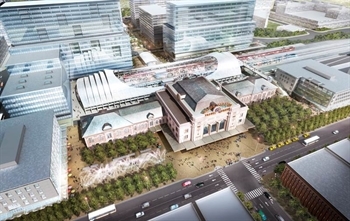
Former rail yard turned bustling neighborhood spurred by transit investment.
Financing the restoration of Union Station was a feat unto itself. Beginning in 1995, a collaboration between the station’s owners (a consortium of three private partners), the City and County of Denver, Colorado Dept. of Transportation (CDOT), RTD, and U.S. Environmental Protection Agency initiated a feasibility study for bringing the building back to life. The Union Station Transport Development Company (USTDC) was formed, funded partly by the RTD, City and County of Denver, CDOT and the private owners. In 1999, the project received a planning grant for projects that link transportation, community and preservation through the Federal Highway Administration's Transportation and Community and System Preservation Pilot Program (TCSP). Following the TCSP grant, Denver was awarded a $500,000 Transportation Enhancements grant to construct a bicycle facility at Union Station. After purchasing the station in 2001, the RTD, CDOT, City and County of Denver, and the Denver Regional Council of Governments formed an Executive Oversight Committee to develop a master and finance plan. Following a three-year public input process, the master plan was finalized in 2004.
In 2004 voters in the eight-county RTD approved a sales tax increase of 0.4 percent (4 pennies on every $10) to finance the FasTracks transit project. Because rehabilitation Union Station was a critical element of the FasTracks system, it, too, was “fast tracked.” In 2006, The Union Station Neighborhood Company (USNC) – a collaboration of Continuum Partners, LLC and East West Partners – were selected as the private developer to oversee planning, development, financing, design and construction for the 20 acres of RTD land surrounding Union Station. USNC also purchased the land from the RTD.
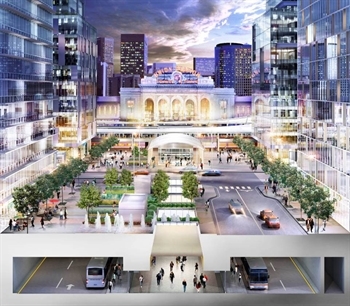
The future Denver Union Station.
In 2008 the Denver City Council created the Denver Union Station Project Authority (DUSPA) to finance, acquire, own, design, renovate, and maintain the transportation and public infrastructure parts of Union Station. DUSPA is a nonprofit, government-owned corporation authorized to issue debt for the project. That debt is only payable from the project. As the transit components of the project are completed, they will be transferred to the RTD who will own and maintain them.
In tandem with the creation of the DUSPA, the Denver City Council approved a 30-year TIF district (called Metropolitan Districts in Colorado) comprised of the entire Union Station and surrounding 20 acres. Tax Increment Financing is a special district created during a development period, where the tax base is frozen at the predevelopment level (on the assumption redevelopment would not occur in the area without public investment or intervention). Property taxes continue to be paid, but taxes derived from increases in assessed values resulting from new development (the tax increment) either go into a special fund created to retire bonds issued to originate the development, or to leverage future growth in the district.
The property taxes generated in the TIF district will go toward the debt services on two federal loans; a $145.6 million Transportation Infrastructure Finance and Innovation Act (TIFIA) loan and a $155 million Railroad Rehabilitation and Improvement Financing (RRIF) Loan. This financing structure is unique in that it is the first time the U.S. Dept. of Transportation combined a TIFIA and RRIF loan for a single project.
Total financing sources include:
|
Source
|
$ Amount in Millions
|
|
TIFIA Federal Loan
|
$145.6
|
|
RRIF Federal Loan
|
$155.0
|
|
Land Sales
|
$39.5
|
|
FasTraks
|
$41.3
|
|
ARRA
|
$28.2
|
|
TIP Funds
|
$2.5
|
|
Colorado Senate Bill 1 Strategic Planning
|
$17.3
|
|
FTA 5309 Fix Guideways Grant
|
$9.5
|
|
Colorado Dept. of Transportation
|
$45.3
|
|
Total
|
$484.2
|
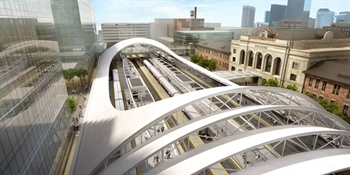
Riders waiting for the next bus at Denver Union Station will have a nice view.
Making this $500 million investment to redevelop its historic Union Station will generate myriad benefits for Denver, including an annual economic return of $3 billion, 31,272 short-term construction jobs, and almost 20,000 long-term jobs. Twenty acres of an abandoned rail yard will become a new vibrant neighborhood surrounding the transit hub. Ten acres of new public plaza will be constructed, as a full $32 million of the $500 million budget was spent on public spaces. Traffic congestion will be reduced and new housing, business and activity centers will come to life. The rehabilitation of Denver Union Station is a perfect example of how a region – leaders and taxpayers alike – came together around a shared vision to creatively finance a project that will transform the city and region for centuries.
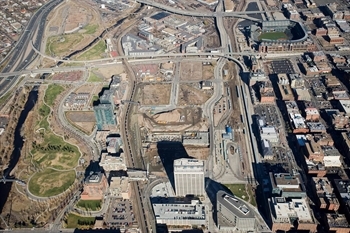
Construction begins at Denver Union Station.